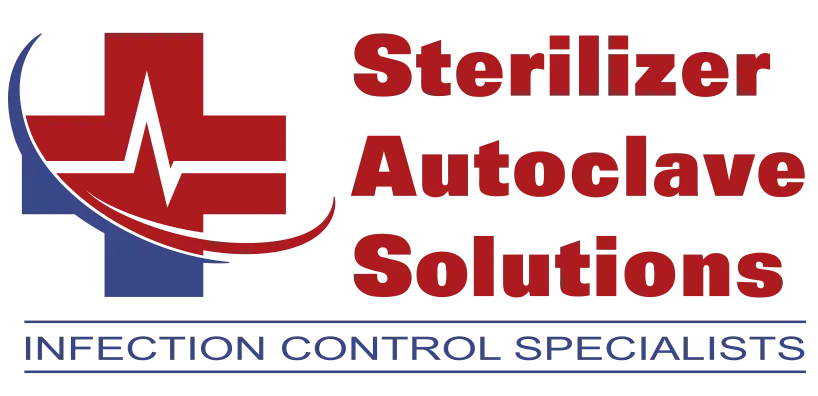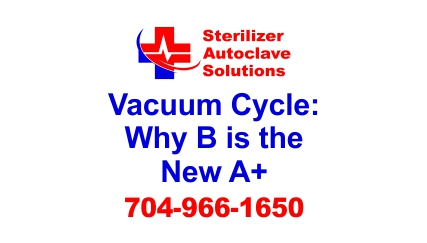Vacuum Cycle: Why B is the New A+ Leave a comment
In this article, we’d like to go over the efficacy of the Class B Vacuum cycle. And if you just want to talk to someone, call our Free Tech Support at 704-966-1650 Option 3.
What’s All the Commotion About?
To put it simply: COVID 19!
With safety being the number one priority coupled with the virus’ relentless invasion of the world and our everyday lives, the medical industry needs to adapt. Research and discussions have been going on around the world about having to upgrade their sanitation methods within medical facilities.
They have been on the hunt for more effective sterilization methods that can eliminate virtually all of any bacteria, pathogens, or any other risks to the safety of patients and staff. For the most part, it comes down to the autoclaves used to sterilize the medical equipment. For a while now the most common method has been Gravity Air Removal (which we’ll get into later). But the latest research that has been coming out of the pandemic is that another method is actually proving much more effective. That method is called Pre/Post Vacuum Air Removal out of a Class B autoclave.
US versus the World
One of the outlying issues at the moment is that our CDC standards aren’t matching the evolving safety practices of those being presented in other countries. For example: on the CDC website it says: ‘between patients, dental health care personnel (DHCP) should clean and heat-sterilize handpieces and other intraoral instruments that can be removed from the air and waterlines of dental units,‘ meaning their guidelines for sterilization aren’t specified to anything.
However, in other areas such as Europe and Australia, the guidelines of infection control differ greatly.
The European Standard, EN 13060, upgraded the performance level of steam sterilizers to medical grade to ensure the prevention of cross-infection. And as it stands, these regulation standards list three types of sterilization cycles, B, S, and N, which all perform different functions for different situations.
- B class cycles are when mechanical pumps exhaust the air inside to create a vacuum, used for hollow instruments and objects with a hollow area that has a diameter of over 1:5.
- S class cycles are meant to serve a variety of certain types and configurations, used with multi-pulse positive vacuum steam sterilizers. This type is manufacturer specified.
- N class cycles are reliant on gravity when steam pushes the air down and out of the bottom of the chamber used for solid, unwrapped items.
Without these specifications and evolutions like other areas, the US standards leave it at an ambiguous standstill. Many voices have been trying to get this to change and have provided the research as to why adapting is the right solution.
Vacuum over Gravity
There are two basic types of steam sterilization, the gravity air removal and pre/post vacuum air removal. Of these two the gravity air removal is the one most commonly used here in the US. But the vacuum air removal is what other countries have been using and people here are pushing the CDC standards to enforce. The research indicates that currently, the vacuum removal is proven significantly more effective than the gravity air removal, but how?
Well, first we explain the basics. Or rather the CDC did when they said this about the gravity air removal process:
“The gravity displacement autoclaves are primarily used to process laboratory media, water, pharmaceutical products, regulated medical waste, and nonporous articles whose surfaces have direct steam contact. For gravity displacement sterilizers the penetration time into porous items is prolonged because of incomplete air elimination.”
To be fair, America hardly used nonporous instruments in the past, which could partially explain the lack of needed evolution. The whole idea of gravity air removal is that since steam is lighter than air it can force it through the air vent in the bottom of the chamber. The problem here being that only 90-95% percent of the air is actually getting out when needed, but it leaves behind pockets of air and pathogens because there is nothing active to keep it flowing out.
However, when it comes to the numbers on the pre/post vacuum air removal, it makes a world of difference for a number of reasons. But like before, the basics:
- The air in the chamber is removed by a few vacuum pulses.
- The actual sterilization takes place after the temperature and pressure increase until they reach a constant level (holding time) in the autoclave.
- The pressure is released to atmospheric pressure via the exhaust valve.
- The temperature and pressure are lowered farther to create a vacuum which causes the water to evaporate into gas. Then all of it is sucked out with a vacuum pump.
This method eliminates more than 99% of the air left within the equipment’s hollow areas and even the chamber itself. Some medical equipment can have particular hazards when it comes to proper sanitation. Dental equipment for instance cannot be easily dismantled due to their very small intricate parts. This makes them harder to sterilize properly and inspect thoroughly. And it’s not just the external parts of them, but also the hard-to-reach internal pieces.
Gravity removal cycles just don’t cut it because they can’t properly penetrate the hollow areas of the instruments, and they can even leave behind residual air that doesn’t get properly cycled out. And in the times we’re in with our current livelihoods being encroached upon by the pandemic, this research showing a new way to properly sanitize equipment is nothing to scoff at.
So What’s the Solution?
The results are in, and the answer is simple: a Class B pre & post -vacuum sterilization autoclave.
Not sure what to do with that? Don’t worry, Tuttnauer does, and they’re not shy in telling you so. In fact they have developed two autoclave sterilizers just for this purpose.
The Tuttnauer T-Edge is the newest countertop autoclave with a feature you can’t find anywhere else. When the industry evolved, so did the T-Edge. With it’s upgrade, (via software) you go from a class S to a class B at a touch of a button.
There is also the Tuttnauer Elara 11D and Elara 9D which are Class B autoclaves with a built in Steam Generator.
These are thel most recommended by those crying out for a mandatory change in sanitation standards. Tuttnauer has risen to the occasion once again with it’s eco-and-user friendly units made for convenience and support in a time where peace of mind is a rare and valued commodity.
With a trusted name and the research to back it up, the Tuttnauer T-Edge and Tuttnauer Elara 11 are definitely two of if not the best answers to the question of “How?”.
Final Thoughts
When it comes down to it, there really is no question; it’s time to change. There shouldn’t be any need or want to stay behind. Especially when the environment and numbers say to move forward, and when not changing comes at the cost of risks to patients and staff. In these times, we need all the help we can get and with Tuttnauer offering the best and very widely accepted solution, changing the way we look at sterilization now will certainly prove extremely beneficial to us in the future.
As always if you have any questions about this process or anything else please feel free to contact us and take advantage of our “FREE TECH SUPPORT.”
We also offer FREE VIRTUAL TECH SUPPORT to “See and Talk” with a “Real Time Live Technician” for any problems you may be in need of help with.
You can also use our “FREE MAINTENANCE PROGRAM”. Take the guesswork and worrying about what unit is due for maintenance and which maintenance cycle it is time for. We will keep track of all your autoclaves and let you know when it’s time for anything.
See our Intro to the Tuttnauer T-Edge article here
See our Intro to the Tuttnauer Elara 11 article here
SARS Covid19 Cultivates Sterilization Process Changes article here


